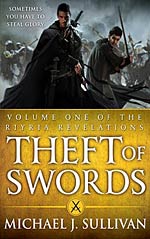
![]() nightxade
nightxade
1/8/2014
![]()
Riyria means "two" in elvish and the two in question are Hadrian Blackwater, the master swordsman, and his shadow partner, Royce Melborn, the brooding master thief. The reputation of Riyria precedes them such that even the local guildsmen know not to cross paths with them, and their skills are so great, that their resume boasts many references from lords and ladies who have used their subterfuge and even assassination services. But when Hadrian falls for a big score that goes against all their rules, unsurprisingly, they end up on the wrong end of a sword. Blamed for the murder of the king, they are set for execution, until the princess gives them a way out: kidnap the prince and take him to a mysterious prison to find a mysterious prisoner.
Theft of Swords collects the first two books in Riyria Revelations series, The Crown Conspiracy and Avempartha. These stories contain a lot of possibility, but as you can tell by my three star rating, they fell short for me. The plot and characters are set up to be amazing, but some how, they failed to truly cross the line into the realm of being memorable. They are missing the "something more" that should make them truly spectacular.
Every time I felt like we were getting somewhere with character building or plot transition, things sped up to the end and/or glossed over what should have been the meat of the development. For example, Hadrian and Royce kidnap the prince, who is a petulant creature that ends up figuring himself out in order to prove himself worthy of taking his father's place. But there was not really a strong interaction to show us the transition. Instead, we got a long inner monologue where he realized that he had to grow up. And that's a major problem in Theft of Swords – a reliance on too much exposition. There are a lot of moments spent divulging a lot of information that, while relevant to the overall world, do not hold any immediate importance to the events, or even slow down the momentum of the story. For example, when Royce is teetering on the edge of a step about to collapse within a tower set to fall apart and kill him and the princess he's trying to rescue, the tension of the moment is completely lost because the dwarf goes into complete schematic detail on how he manufactured the elaborate trap. And as much as I want to know about Royce's shadowy past, I didn't need him to meet up with a group of bad guildsmen who's only purpose seemed to be to detail Royce's shadowy past. Oh and to deliver a message about a girl who needed Riyria's help.
Hadrian and Royce disappointed me the most. They should have been a dynamic duo, but instead, I found myself wondering what the elvish word for "one" was. The characters aren't interchangeable, but I felt that their personalities weren't clearly defined well enough beyond "charming warrior" and "shadowy thief" to actually require both of them, save in moments when they were needed to be in two different places at once, being warriory and thiefy, respectively. Fortunately, by the end of the second book, things got a little bit better and the female characters, Princess Arista and the commoner, Thrace, likewise became a bit more interesting.
Still, I did really like the way Sullivan included fantasy standards of elves, dwarves, magic and mythical beasts, but did not place them at the forefront of the story. Here, elves are a downtrodden race and there are some enticing hints of future conflicts and interactions that I hope will be fully realized.
Esrahaddon, the maimed and imprisoned wizard, is also an intriguing character. Though he too often gets to reveal the answer to all the riddles, rather than letting our heroes do so, I look forward to learning more about him. He is a man with plans within plans that promise a lot more intrigue ahead.
http://bibliosanctum.blogspot.com